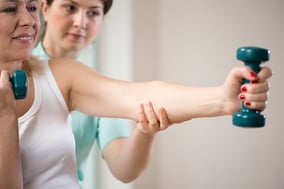 According to the National Osteoporosis Foundation, 54 million people either already have osteoporosis or are at high risk for developing the disease due to low bone mass. The consequences of this very common and often debilitating disease can be severe and in some cases, even life threatening. Studies suggest that approximately one in two women and up to one in four men age 50 and older will break a bone due to osteoporosis, and serious fractures in the hip or spine are among the most common. Knowing what steps to take to preserve bone health is essential. So what can be done to prevent osteoporosis, or, for those already diagnosed with the disease, minimize its effects?
According to the National Osteoporosis Foundation, 54 million people either already have osteoporosis or are at high risk for developing the disease due to low bone mass. The consequences of this very common and often debilitating disease can be severe and in some cases, even life threatening. Studies suggest that approximately one in two women and up to one in four men age 50 and older will break a bone due to osteoporosis, and serious fractures in the hip or spine are among the most common. Knowing what steps to take to preserve bone health is essential. So what can be done to prevent osteoporosis, or, for those already diagnosed with the disease, minimize its effects?
Get Tested, and if Necessary, Treated
The first step in preventing or minimizing osteoporosis is finding out where you currently stand in terms of bone health. That means talking to your doctor about bone density testing. A bone density test measures – most commonly via specialized x-ray technology – bones, such as the hip, spine and heel, to evaluate bone strength and density and determine your potential risk for osteoporosis. If testing shows that you are developing osteoporosis or have lost enough bone to be at high risk, today's advanced medications can prevent further bone loss or even help increase bone strength and density. So get started with treatment as soon as possible and stick with it, since doing so can help you avoid the most serious potential complications of the disease.
Feed Your Bones
Keeping your bones healthy and preventing further damage to weakened bones means providing them with plenty of the essential nutrients they need for repair and maintenance. That means making sure you're getting 1,000 mg of calcium daily if you're under the age of 50 and 1,200 mg if you're over 50. Foods rich in calcium include dairy products, fortified juices, sardines with bones, soy products, and green, leafy vegetables. If you're having a hard time getting enough in your diet, talk to your doctor about calcium supplements.
To help that calcium do its job, you'll also need to make sure that you're getting plenty of vitamin D since low levels can inhibit calcium absorption. Adults under age 50 need 400 to 800 IU daily, and those age 50 or older need 800 to 1,000 IU. Sources of vitamin D include sunlight and some foods, such as fatty fish and fortified dairy products. Getting enough vitamin D from diet alone can be difficult, so if you aren't getting daily sun exposure, speaking to your doctor about supplements may be wise.
Get Regular, Weight Bearing Exercise
Daily exercise is essential to bone health. Weight-bearing exercise stimulates the production of new bone cells, the stress it places on the bones serving as a signal that more bone tissue is needed to build the strength bones need to handle that stress. Spending at least 30 minutes a day on gentle, low-impact exercise can make a big difference in bone health, slowing bone loss or even improving the strength and density of your bones. If you already have weakened bones, talk to your doctor or a physical therapist for advice on a safe exercise plan.
So there are the basics on protecting bone health. Being proactive about testing, treatment, and healthy lifestyle changes can make a big difference in your quality of life if you've been diagnosed with osteoporosis, significantly slowing progression of the disease or even, in some cases, reversing bone loss to some degree. If you haven't, these measures can help you make sure that such a diagnosis isn't in your future.





